Over the past few weeks, I have been thinking again and again about Trilogy, an installation by Rayyane Tabet at MUDAM in Luxembourg. I wasn’t planning to write about it but the work is haunting me. I think about it when i read about Israeli strikes killing civilians in Lebanon, when i see the videos of Palestinians whose homes have been ransacked by settlers or when i hear about the alarming levels of pollution in Beirut. And i think about it when i see Klein Blue.
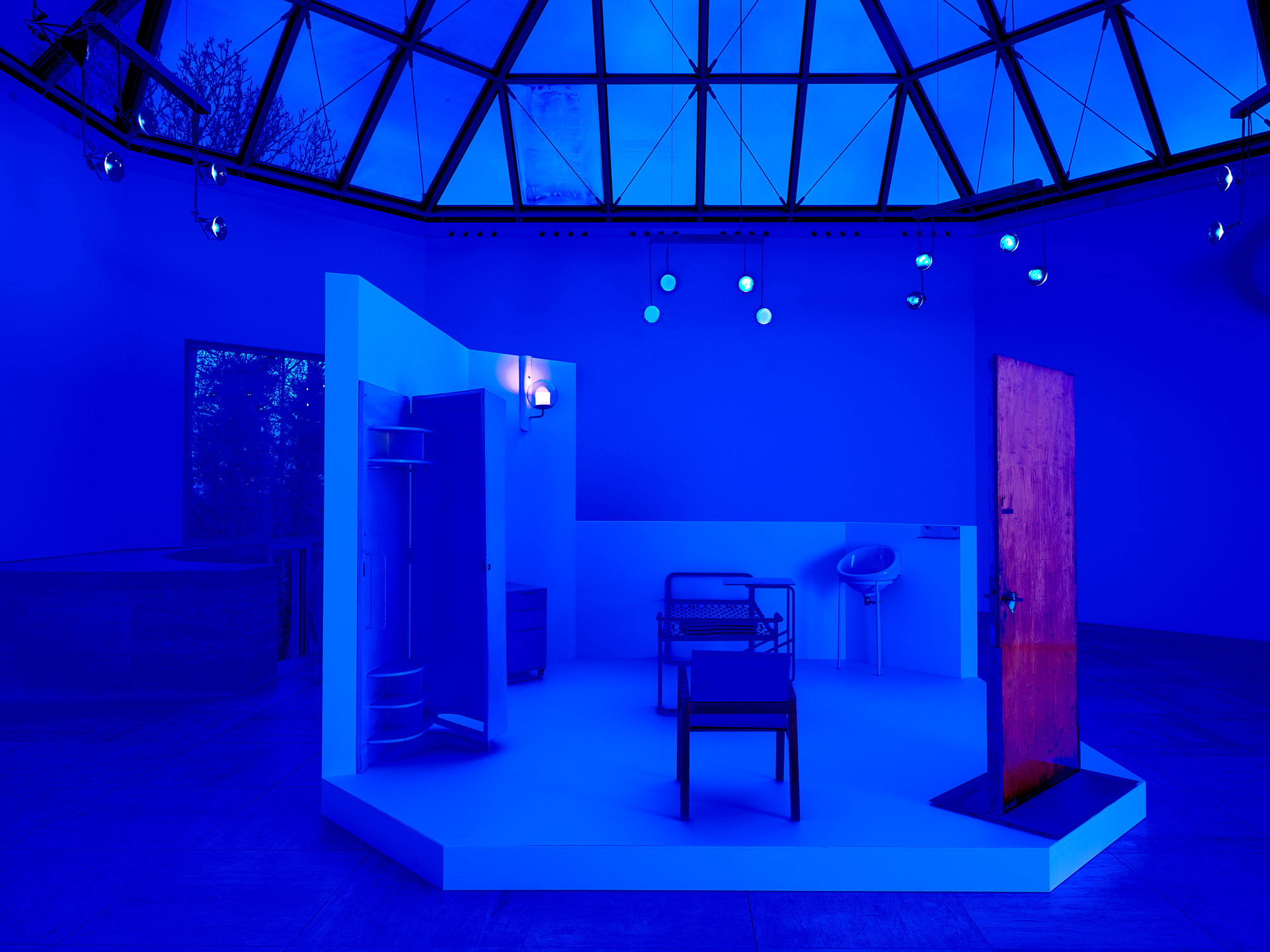
Installation view of ‘A Model: Prelude’ by Rayyane Tabet at Mudam, Luxembourg. Photo: © Studio Rémi Villaggi | Mudam Luxembourg

Installation view of ‘A Model: Prelude’ by Rayyane Tabet at Mudam, Luxembourg. Photo: © Studio Rémi Villaggi | Mudam Luxembourg
I wasn’t even planning to enter that part of the museum during my visit, but then i saw this long, luminous corridor bordered by long white curtains. The intriguing and inviting passage links MUDAM’s main building to a pavilion designed by Ieoh Ming Pei, the architect of the Louvre Pyramid.
The curtains belonged to the artist’s grandparents. When they married in the 1950s, they could not afford their own place so they moved into the apartment of the groom’s family in Beirut. To celebrate the union, his grandmother ordered new curtains. The off-white sheer curtains were cut in an innovative material called Tergal.
A cheap alternative to silk, Tergal is made from a variety of synthetic filament yarns like polyester, nylon and rayon. A dark history hides behind the lightness and versatility of the fabric. During the Second World War, Nazi Germany used political prisoners and forced labour to produce rayon across occupied Europe. Rayon also contains Carbon Disulfide, an extremely toxic compound that harms the health of workers overseeing the weaving process, contaminates the soil and may also harm the health of people and animals living near rayon plants.
The curtains were the perfect entry point to an installation that weaves together light, glass, war and architecture. The three part installation (the curtain corridor, a blue room and a shelf covered in jugs made of glass retrieved from the Beirut explosion) uses ordinary objects to bring together the history of the museum, Tabet’s personal memories and the quick succession in Lebanon of a revolution, a pandemic, a massive explosion, a seemingly endless recession and increased tensions with Israel.
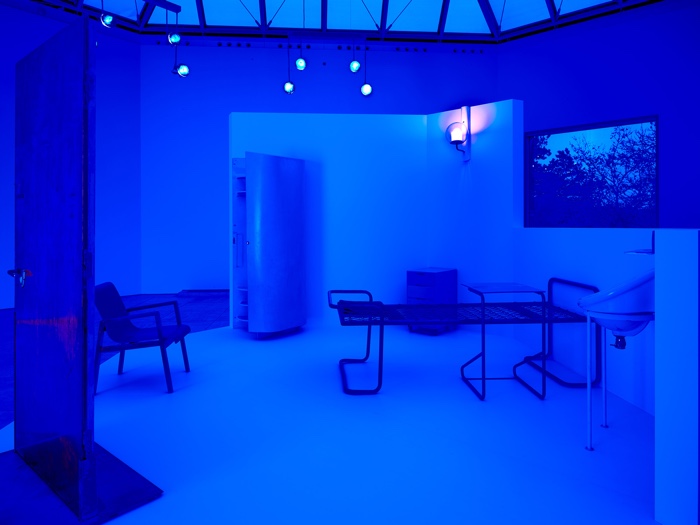
Installation view of ‘A Model: Prelude’ by Rayyane Tabet at Mudam, Luxembourg. Photo: © Studio Rémi Villaggi | Mudam Luxembourg
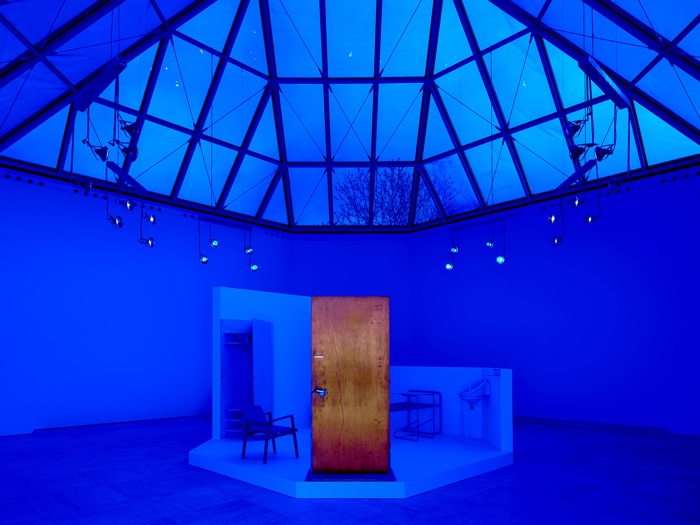
Installation view of ‘A Model: Prelude’ by Rayyane Tabet at Mudam, Luxembourg. Photo: © Studio Rémi Villaggi | Mudam Luxembourg
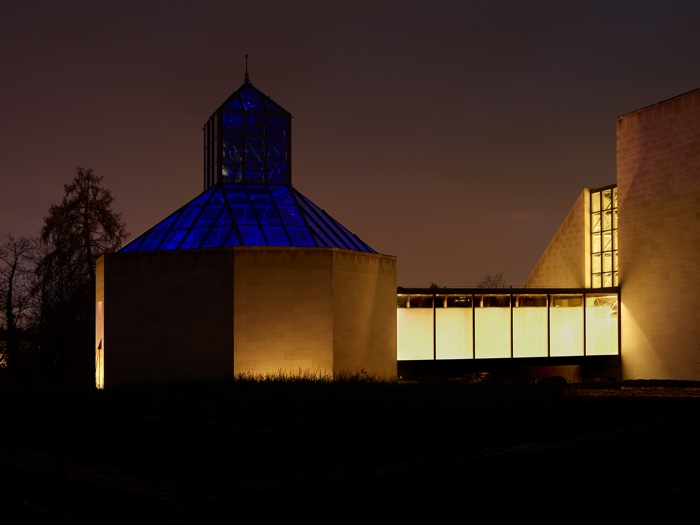
Installation view of ‘A Model: Prelude’ by Rayyane Tabet at Mudam, Luxembourg. Photo: © Studio Rémi Villaggi | Mudam Luxembourg
The interior of the Pavilion itself is bathed in blue light. Only a wooden door seems to escape the blue glow. Along with a wardrobe, an armchair, a bed, a lamp and other pieces of furniture, the door comes from one of the rooms of the Sanatorium Paimio, designed by Alvar and Aino Aalto between 1930 and 1933. The Aaltos designed the building and the furniture to contribute to the well-being and recovery of patients suffering from tuberculosis. Air needed to flow, light entered everywhere, dust had to be easily swiped out.
I assumed that the blue light had been chosen for its antimicrobial properties. In reality, blue light also has a much more sinister story. It evokes the Six-Day War between Israel and a coalition of Arab states (primarily Egypt, Syria and Jordan) from 5 to 10 June 1967. At the time, curfews were imposed all over the Arab world. All sources of light had to be turned off to make it harder for Israeli planes to target houses and key infrastructure at night. Thinking that blue light would make their home less visible from bomber planes, people began painting their apartment windows and their car headlights with a water-diluted indigo blueing agent. This is how, over the course of six nights, the entire Arab World fell into a deep blue darkness.
When seen from the outside at night, the Pavilion gently emits a blue glow. Like a gesture of solidarity with the people who go to sleep today fearing that they –or their loved ones– will not be there tomorrow.
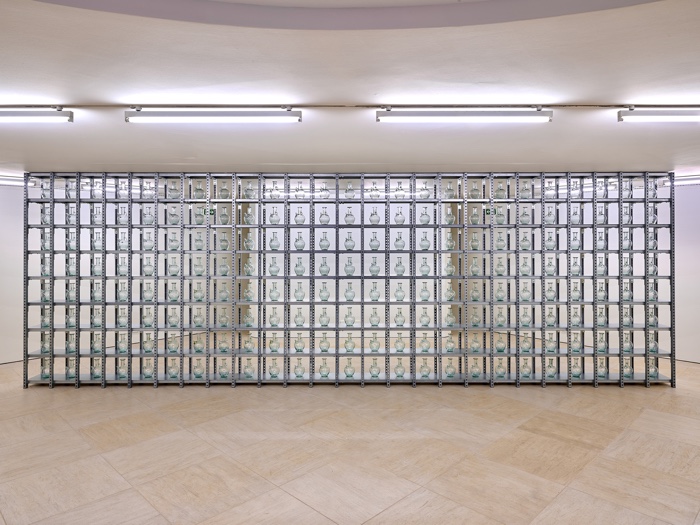
Installation view of ‘A Model: Prelude’ by Rayyane Tabet at Mudam, Luxembourg. Photo: © Studio Rémi Villaggi | Mudam Luxembourg
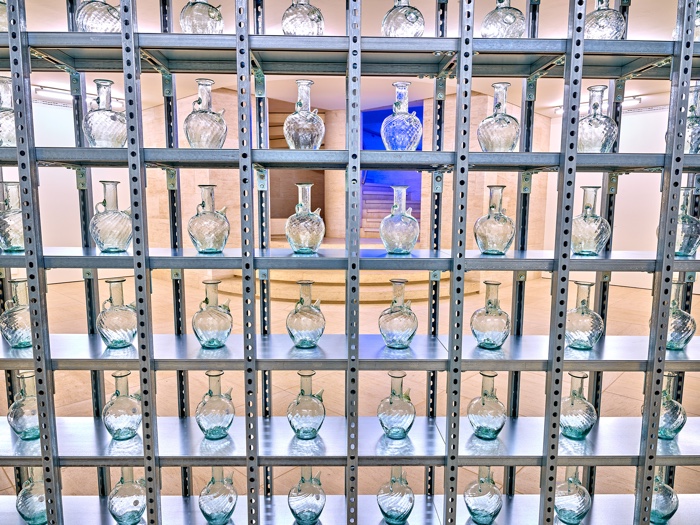
Installation view of ‘A Model: Prelude’ by Rayyane Tabet at Mudam, Luxembourg. Photo: © Studio Rémi Villaggi | Mudam Luxembourg
The last part of the installation is located in the lower floor of the pavilion where the artist placed a series of identical glass jugs on a big shelf. The objects were made from the fragments of window panes collected after the 2020 Beirut explosion. On the 4th of August, 2,750 tons of ammonium nitrate improperly stored in a warehouse in the Beirut port exploded, causing 230 deaths, 7,000 injuries and leaving an estimated 300,000 people homeless. Material damages amounted to tens of billions of euros. Most of the glass which smashed from the buildings’ windows was destined for landfills, until Ziad Abichaker decided to collect the fragments. The environmental engineer and political activist sent the debris to glass-making factories that were struggling because the currency devaluation preceding the explosion had made raw materials too expensive.
Although the water jugs suggest a symbolic repair, they also remind us that, to this day, not a single person has been held responsible for the blast.
Leaving the MUDAM, i looked back at Ieoh Ming Pei’s pavilion and its glass architecture suddenly looked fragile.
“Though conceived a year and a half ago, this project appears to resonate with the present moment,” Tabet told Luxembourg Times. “This is not just about the current events; it spans over 75 years in the case of Palestine and goes back hundreds, if not thousands, of years – histories marked by dispossession, colonisation and a disregard for certain human lives over others.”
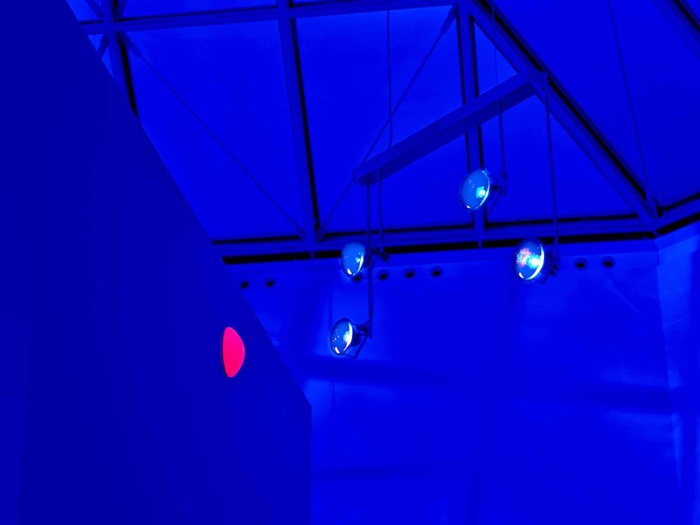
Installation view of ‘A Model: Prelude’ by Rayyane Tabet at Mudam, Luxembourg. Photo: © Studio Rémi Villaggi | Mudam Luxembourg
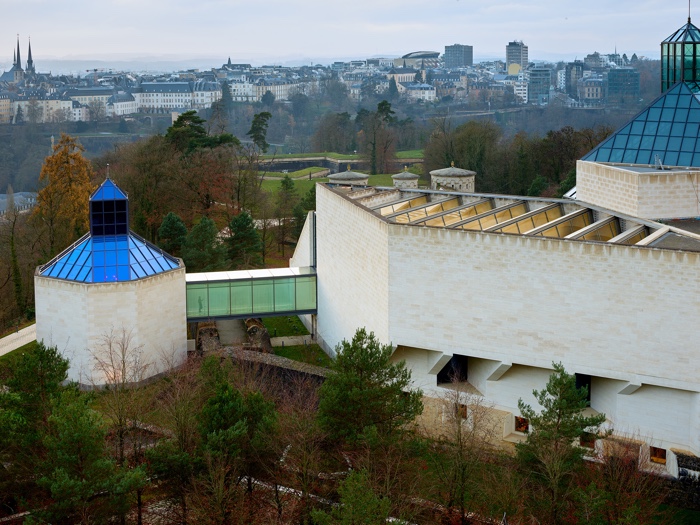
Installation view of ‘A Model: Prelude’ by Rayyane Tabet at Mudam, Luxembourg. Photo: © Studio Rémi Villaggi | Mudam Luxembourg
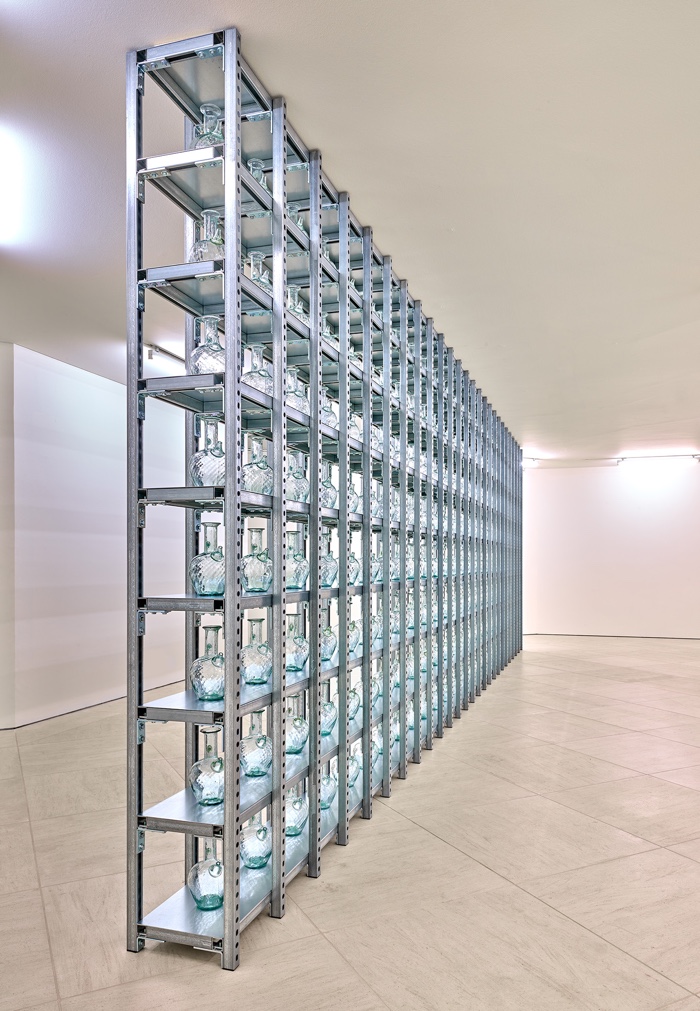
Installation view of ‘A Model: Prelude’ by Rayyane Tabet at Mudam, Luxembourg. Photo: © Studio Rémi Villaggi | Mudam Luxembourg
Rayyane Tabet. Trilogy is at MUDAM Luxembourg until 12 May. Trilogy is the Prelude act of A Model, an exhibition trilogy running across 2023 & 2024.
Related story: Air Pressure. Living under a hostile sky.
